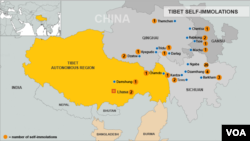The two teenagers who set themselves on fire on Monday in Amdo Ngaba (Ch:Aba, Sichuan Province) have died, according to reliable exile sources.
18 year old monk Lobsang Kalsang, and 17 year old Dhamchoe, a former monk at Kirti monastery, set themselves on fire around 9 am and were reported to have shouted slogans against Chinese policies in Tibet while engulfed in flames. The incidence took place outside the east gate of Kirti monastery, near a street referred to as "Martyr Street" by local Tibetans, because of the high number of self- immolations that have occurred on the street over the past year.
In a sad turn of events, Lobsang Yeshi, a spokesperson for Kirti monastery in India stated that Dhamchoe’s sister, Tenzin Chedron, had herself died through self-immolation on February 11, 2012.
State Department spokeswoman Victoria Nuland said Monday that she had not been informed of the self-immolations but again called on China to respond to Tibetan concerns.
“You know that whenever we see these tragic incidents, we again call on China to meet the legitimate grievances of the Tibetan people within China, to protect their human rights, to protect their way of life and to work on these issues through dialogue.”
Monday’s self-immolations bring the number of Tibetans who carried out self-immolation protests since 2009 to 51, with more than half of them occurring in the town of Ngaba.
Ngaba’s Kirti monastery, founded in 1472 by a disciple of Tsongkhapa, has been the center of Tibet’s self-immolation protests. It is one of the most important religious centers in the area with around 3,000 monks in residence.
China has routinely responded to Tibetans expressing dissent through self-immolation by stepping up security and clamping down to suppress information and images from reaching the outside world. While the PRC’s foreign ministry blames groups outside China, including the Dalai Lama and the Tibetan exile government for protests and unrest that take place in Tibet, some analysts and experts point out that China appears to have neither the will nor the wherewithal to start addressing its problems in Tibet and Tibetan areas.
The U.S. Congressional-Executive Commission on China released a special report on the Tibetan self-immolations last week that noted the correlation between the rise of self-immolations in Tibet with China’s increasing repression in Tibet, and the lack of progress in the dialogue process between China and the Dalai Lama.
18 year old monk Lobsang Kalsang, and 17 year old Dhamchoe, a former monk at Kirti monastery, set themselves on fire around 9 am and were reported to have shouted slogans against Chinese policies in Tibet while engulfed in flames. The incidence took place outside the east gate of Kirti monastery, near a street referred to as "Martyr Street" by local Tibetans, because of the high number of self- immolations that have occurred on the street over the past year.
In a sad turn of events, Lobsang Yeshi, a spokesperson for Kirti monastery in India stated that Dhamchoe’s sister, Tenzin Chedron, had herself died through self-immolation on February 11, 2012.
State Department spokeswoman Victoria Nuland said Monday that she had not been informed of the self-immolations but again called on China to respond to Tibetan concerns.
“You know that whenever we see these tragic incidents, we again call on China to meet the legitimate grievances of the Tibetan people within China, to protect their human rights, to protect their way of life and to work on these issues through dialogue.”
Monday’s self-immolations bring the number of Tibetans who carried out self-immolation protests since 2009 to 51, with more than half of them occurring in the town of Ngaba.
Ngaba’s Kirti monastery, founded in 1472 by a disciple of Tsongkhapa, has been the center of Tibet’s self-immolation protests. It is one of the most important religious centers in the area with around 3,000 monks in residence.
China has routinely responded to Tibetans expressing dissent through self-immolation by stepping up security and clamping down to suppress information and images from reaching the outside world. While the PRC’s foreign ministry blames groups outside China, including the Dalai Lama and the Tibetan exile government for protests and unrest that take place in Tibet, some analysts and experts point out that China appears to have neither the will nor the wherewithal to start addressing its problems in Tibet and Tibetan areas.
The U.S. Congressional-Executive Commission on China released a special report on the Tibetan self-immolations last week that noted the correlation between the rise of self-immolations in Tibet with China’s increasing repression in Tibet, and the lack of progress in the dialogue process between China and the Dalai Lama.






